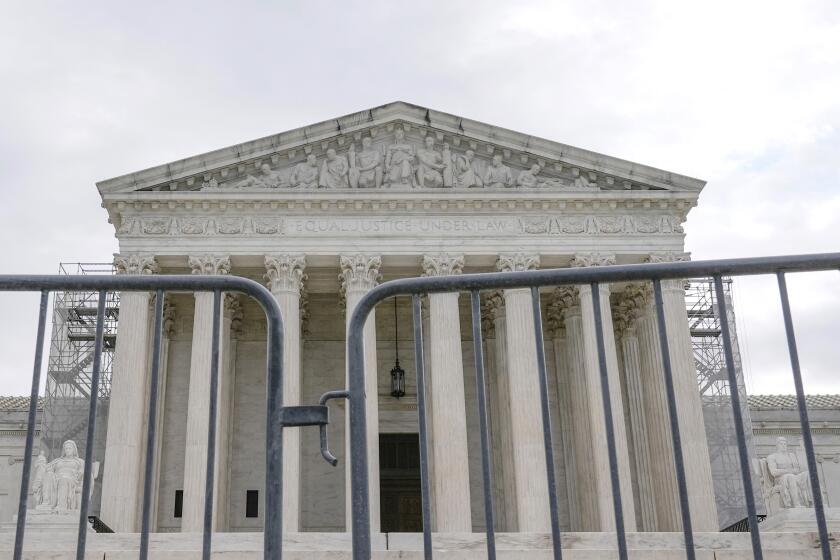On Immigration, Bush Mines His Texas Tactics
Maybe it’s the subject matter, but the immigration debate is bringing out the Texan in President Bush.
In his approach to immigration, Bush is reprising two distinct elements of his strategy as Texas governor.
One of those strategies has improved Bush’s odds of signing comprehensive immigration reform. The second has diminished his chances of success. To coax a bill to his desk, Bush in the weeks ahead needs to employ more of what worked in Texas and less of what didn’t -- if it’s not already too late to change course.
In the immigration debate, Bush is reverting to his gubernatorial strategy by emphasizing consensus -- a word that as president he has sometimes seemed to choke on. As governor, on most issues he really did try to operate as a “uniter, not a divider,” as he has described himself. He generally minimized partisan rhetoric, personally courted Democratic legislators, and offered them concessions in disputes over welfare and taxes.
That hasn’t been his pattern in Washington. As president, Bush usually seeks to advance his aims by unifying Republicans; when necessary, he courts a few conservative Democrats to top off a legislative majority, but he has rarely aimed his proposals at the center of both parties.
On illegal immigration, though, Bush has pursued a more conciliatory course. He has rejected the baseline contention of most GOP conservatives that it is possible to control the problem through tougher enforcement alone. Instead, he has joined the center-to-left voices that maintain that real progress will come only from marrying tougher enforcement to a guest-worker program.
On several specific issues in the debate, Bush has landed to the right of most Democrats and centrist Republicans. But overall, he has created a tone conducive to bipartisan bargaining.
Bush has promoted such a positive environment in a more basic way. He’s often accepted polarization in the country and Congress as the price of achieving his goals. Usually, he argues that a leader’s job is to set a decisive direction, not build consensus.
But on immigration, Bush defines consensus as good in itself. He often emphasizes that Washington must avoid an immigration debate that polarizes society: “People should not pit neighbor against neighbor ... in our country,” he says.
It’s part of a larger pattern with Bush; although he frequently invites conflicts on national security, economic and some social issues, he almost always avoids a confrontational approach on questions with racial and ethnic overtones, such as immigration or affirmative action.
More focus on conciliation would serve Bush well on all the challenges he confronts. But it’s especially apt for immigration. Any package needs to harmonize diverse interests. And with his own party split, Bush needs Democratic support to pass a broad plan. In both those respects, Bush’s tilt back toward his deal-making Texas strategy improves his chances of reaching an immigration agreement.
But the second echo of Bush’s Texas years diminishes his prospects. On immigration, he’s also employing a strategy he used during his greatest legislative setback as governor -- a failed attempt to revamp the Texas tax code in 1997.
In that fight, Bush was far-sighted in pushing the state to confront inequality between rich and poor school districts and excessive reliance on property taxes to fund education. But his proposed changes initially drew little support. That’s when he turned to the tactic he’s using on immigration -- embracing any bill that could keep the process moving through the Legislature.
In Texas, Bush supported Democrats in the state House of Representatives as they reconstructed and revived his tax plan. “He did not criticize us,” said then-state Rep. Paul Sadler, who led the Democratic effort. “He simply said ... ‘You don’t like my plan, bring me a better plan.’ ” Yet after the revised plan passed the state House, Bush frustrated Sadler by refusing to challenge the right-leaning state Senate as it produced a much more conservative alternative.
Bush told Sadler his goal was to get any plan out of the Senate so that the two sides could reach agreement in a conference committee. But Sadler accurately warned Bush that he was allowing the gap between the two chambers to widen to the point where they might be unable to agree. When that did happen, Bush was forced to accept a minimalist compromise.
Bush may have already replicated the mistake on immigration. Last December, the U.S. House of Representatives approved legislation that championed conservative enforcement priorities -- including a massive border fence and a provision that would make criminals of the estimated 12 million illegal immigrants in the U.S. -- but rejected a guest-worker program. Rather than restrain the House, Bush mostly praised its efforts.
His goal was to get any bill he could from the House. The administration assumed that the Senate would produce a more balanced package, allowing Bush and his allies to meld the two in conference.
But, just as with tax reform in Texas, Bush may have allowed the gap between the two chambers to grow so wide that no agreement will be possible, even if the Senate overcomes its own divisions to pass an immigration bill.
If Bush is to avoid that fate, he’ll need to accept more responsibility for steering Congress toward agreement. The most valuable thing he could do now is explain, in greater detail, what kind of final agreement he believes could create consensus -- even if that exposes him to more conflict with House conservatives. Without such a signal from the top, the push for an immigration overhaul could easily fragment into stalemate, just as the debate over Gov. Bush’s tax plan did.
Surely, that’s one element of his Texas experience Bush can’t be eager to relive.
More to Read
Get the L.A. Times Politics newsletter
Deeply reported insights into legislation, politics and policy from Sacramento, Washington and beyond. In your inbox three times per week.
You may occasionally receive promotional content from the Los Angeles Times.






